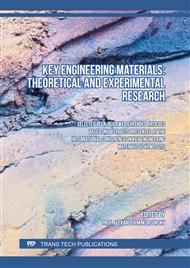[1]
R. Guo, Cross-Border Environmental Pollution and Management, in: Cross-Border Resource Management (Third Edition), Elsevier, 2018, pp.233-268.
DOI: 10.1016/b978-0-444-64002-4.00009-x
Google Scholar
[2]
National Geographic, Clean Water Crisis Facts and Information. Freshwater Crisis. (2010).
Google Scholar
[3]
S. Benkhaya, S. Harfi, A. Elharfi, Classifications, properties and applications of textile dyes: A review, Appl. J. Envir. Eng. Sci. 3 (2017) 311-320.
Google Scholar
[4]
L. Ardila-Leal, R. Potou-Pinales et. al, A Brief History of Colour, the Environmental Impact of Synthetic Dyes and Removal by Using Laccases, Molecules 26 (2021) 40.
DOI: 10.3390/molecules26133813
Google Scholar
[5]
A. Inyinbor, B. Adebesin, A. P. Oluyori et. al, Water Pollution: Effects, Prevention, and Climatic Impact in In M. Glavan (Ed.), Water Challenges of an Urbanizing World, IntechOpen, (2018).
Google Scholar
[6]
B. Lellis, C. Z. Favaro-Polonio et. al, Effects of textile dyes on health and the environment and bioremediation potential of living organisms, Biotech. Res. and Innov. 3(2), (2019) 275-290.
DOI: 10.1016/j.biori.2019.09.001
Google Scholar
[7]
S. Affat, Classifications, Advantages, Disadvantages, Toxicity Effects of Natural and Synthetic Dyes: A review, University of Thi-Qar Journal of Science 8, (2021) 130-135.
Google Scholar
[8]
M. Foroughi-dahr, H. Abolghasemi et. al, Adsorption Characteristics of Congo Red from Aqueous Solution onto Tea Waste, Chem. Engg. Comm. 202 (2015).
DOI: 10.1080/00986445.2013.836633
Google Scholar
[9]
A. Singh, D.B. Pal, et. al, Biological remediation technologies for dyes and heavy metals in wastewater treatment: New insight. Bioresource Technology 343, (2022) 126154.
DOI: 10.1016/j.biortech.2021.126154
Google Scholar
[10]
M.K. Erdoğan, M. Karakişla, Simultaneous Deposition of Poly(o-Anisidine) and Noble Ag Particles on Wool Fabric and The Evaluation of Its Performance as Catalyst in Dye Reduction, Journal of the Turkish Chemical Society Section A: Chemistry 6(2), (2019) 225–236.
DOI: 10.18596/jotcsa.512360
Google Scholar
[11]
Y. K. Manea, A.M. Khan, S. A. Nabi, Facile synthesis of Mesoporous Sm@ POA/TP and POA/TP nanocomposites with excellent performance for the photocatalytic degradation of MB and MG dyes . Journal of Alloys and Compounds 791, (2019) 1046–1062.
DOI: 10.1016/j.jallcom.2019.03.091
Google Scholar
[12]
V. Dhanabalan, Kapok Fibre: A Perspective Fibre (2015).
Google Scholar
[13]
R. B. Gapusan, M. D. L. Balela, Adsorption of anionic methyl orange dye and lead(II) heavy metal ion by polyaniline-kapok fiber nanocomposite. Materials Chemistry and Physics 243, (2020) 122682.
DOI: 10.1016/j.matchemphys.2020.122682
Google Scholar
[14]
M. U. Herrera, C. M. Futalan, R. Gapusan, M. D. L. Balela, Removal of methyl orange dye and copper (II) ions from aqueous solution using polyaniline-coated kapok (Ceiba pentandra) fibers. Water Science and Technology, 78(5), (2018) 1137–1147.
DOI: 10.2166/wst.2018.385
Google Scholar
[15]
A. Agcaoilli, M. Herrera, C. Futalan, M.D.L. Balela, Fabrication of Polyacrylonitrile Coated Kapok Hollow Microtubes for Adsorption of Methyl Orange and Cu(II) Ions in Aqueous Solution, Journal of Taiwan Institute of Chemical Engineers, 78, 359-369 (2017).
DOI: 10.1016/j.jtice.2017.06.038
Google Scholar
[16]
M.D.L. Balela, N.M. Intila, S.R. Salvanera, Adsorptive Removal of Lead Ions in Aqueous Solution by Kapok-Polyacrylonitrile Nanocomposites, Materials Today Proceedings, 17, 672-678 (2019).
DOI: 10.1016/j.matpr.2019.06.349
Google Scholar
[17]
Y. Liu, J. Wang, Y. Zheng, A. Wang, Adsorption of methylene blue by kapok fiber treated by sodium chlorite optimized with response surface methodology. Chemical Engineering Journal, 184, (2012) 248–255.
DOI: 10.1016/j.cej.2012.01.049
Google Scholar
[18]
K. Khamngoen, N. Paradee, A. Sirivat, Chemical oxidation polymerization and characterization of poly ortho-Anisidine nanoparticles. Journal of Polymer Research, 23(9), (2016) 172.
DOI: 10.1007/s10965-016-1073-7
Google Scholar
[19]
M.I. Khan, M.K. Almesfer et. al, Conductive Polymers and Their Nanocomposites as Adsorbents in Environmental Applications, Polymers, 13(21), (2021).
DOI: 10.3390/polym13213810
Google Scholar



